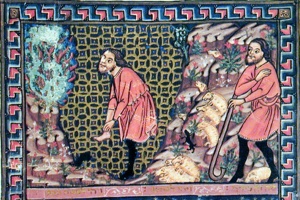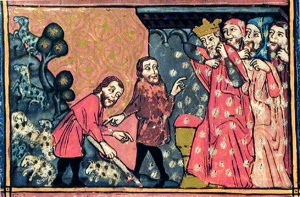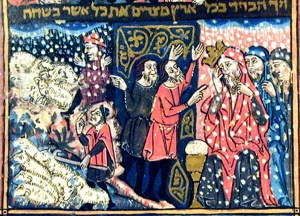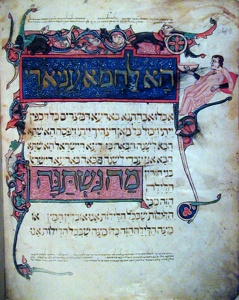The Rylands Haggadah: A Cry from Catalonia
I want to take you on a journey to a land where Jews once flourished. They even felt secure enough to make this masterful illuminated manuscript, the Rylands Haggadah. This Jewish community had been fully legitimate citizens of the Iberian Peninsula for over three hundred years as a minority population under first the Moslems and then the Christians. They were valued members of society, acting as doctors, ministers, financiers and diplomats. They had developed a sophisticated literature and poetry, not to mention some of the greatest thinkers in the Jewish world. Maimonides and Judah Halevi were the children of this tolerant civilization.
Then, sometime in the first half of the 13th century, the political and religious climate darkened. The Christian rulers of Spain, who had welcomed the Jewish inhabitants of the newly reconquered lands, now began to see the Jews as being a “problem” that could only be solved by their conversion to Christianity. The first flare up of hostility was in the Barcelona Disputation of 1263. The Ramban, as representative of the Jews of Gerona and Catalonia, was ordered to debate with a Dominican friar (an apostate Jew) at a tribunal headed by James, the King of Aragon. The subject was the references to the Messiah found in Tanach and the Gemara. By most accounts the outcome of this debate was a draw in so much as each side thought they had won. Alas, this was but the beginning of further pressures, decrees and forced sermons that, finally more than two hundred years later, resulted in conversion of many Jews and the mass expulsion of all Jews from Spain. But let us step back from the precipice for a moment.
In the thirteenth and fourteenth century there was a flowering of the art of the illuminated manuscript among the Jews of Europe. And the most frequent text chosen to be illuminated was the Haggadah shel Pesach. From 14th century there are approximately twenty Haggadot that survive from Northern France, the Rhineland, Southern Germany and Spain. Of these, the majority is from Catalonia in northeastern Spain. The Rylands Haggadah is one of these masterpieces of the Catalan Haggadot.
The format of the Catalonian Haggadot is characterized by a series of full page miniatures that proceed the text of the Haggadah itself. These miniatures normally depict narratives from the Torah, either starting with Beraishit or concentrating on the Passover story itself. Usually at the end of the narrative cycle the miniatures conclude with depictions of the preparation and the celebration of the holiday in contemporary fourteenth century settings.
The Rylands Haggadah’s thirteen pages of miniatures (two per page) begin with Moses at the Burning Bush and conclude with the Children of Israel crossing through the sea on dry land and the injunction to “to take a lamb for each family household… and roast it over fire.” The majority of the miniatures depict the plagues that afflicted the Egyptians and the wonders that proceeded our exodus from Egypt. The choice of subjects and the way they are depicted reflects the situation of the Jews of Catalonia in the 1370s. Art and Torah are being utilized here to express the longings and triumph of the spirit of that Jewish community.

The very first miniature establishes the reverent tone of the entire cycle with Moses before the Burning Bush. God summons us in wonders and we heed His call. Even the sheep Moses is pasturing turn toward the bush in wonder. I should point out that these illuminations should be “read” right to left and depict what is called a continuous narrative wherein the main character may appear more than once in the scene, as if in multiple frames of a motion picture. First Moses turns aside to look at the bush, then he removes his shoes. This technique moves the narrative along so that no scene is frozen in time. Also all the characters are depicted in local dress of fourteenth century Spain which adds to the contemporary tone of the Haggadah. Everything about this Haggadah makes the Biblical feel contemporary and vibrant. It is not hard to imagine yourself there now.

The plagues are depicted with a political vengeance that was surely deeply felt by the Jews of Catalonia. Pharaoh cringes while his magicians cower behind him as Moses and Aaron dutifully direct a plague of enormous lice to its victims of King, man and beast alike. Thus attacked by lice, Pharaoh rises up in the presence of the humble Moses who commands the center of the panel.
In another miniature further punishment is meted out as hail pelts Pharaoh with such force that his crown is dislodged. In the upper left a shepherd mourns his devastated flock while a Jewish shepherd and his flock are unaffected immediately below. Again we see these signs and wonders are directed by Moses and Aaron, centrally placed, who acknowledge by their gestures that all these events come from Heaven itself.

In each and every one of the twenty-six miniatures the sense of triumph and vindication is palpable. This Haggadah expresses the reality of the oppression and anxiety of their times and the heartfelt cry, “Let my people go”. At the very least when the Jews of Catalonia read this Haggadah at the seder they felt that the triumph of Yeitziat Mitzraim could be theirs also. No more forced sermons, no more oppression from the King and no more conversions.
Then the Haggadah proceeds with the kiddush and the next text illuminated is Ha Lachma Onyah, This is the Bread of our affliction. This sumptuous page in gold, blue, and delicate pinks and greens indulges in the full gamut of medieval fantasies to excite the interest and fascination of the reader. But most important is the reclining figure on the upper right. He reclines on his left arm on a red pillow and presents a basket or bowl for the matzot to be held aloft. Relaxed and dressed in a robe of leisure and purity, this figure is emblematic of the fact that on this night, at least, we recline because, yes, we are free. And as free men and women we begin to recount how God took us out of the land of Egypt so that He could be our God and we could be His people.

Next week, God willing, this masterpiece of fourteenth century Jewish Art, the Rylands Haggadah, will further help us to understand better our Festival of Matzot as truly the time of our Freedom.
The Rylands Haggadah: A Medieval Sephardi Masterpiece in Facsimile, The John Rylands University Library of Manchester, England, Harry N. Abrams, Inc. New York